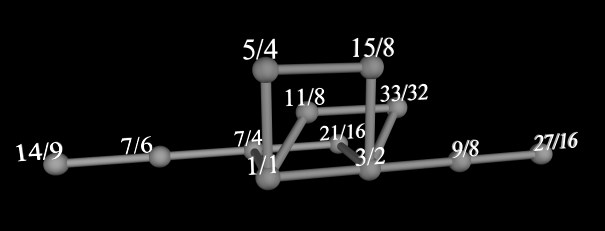
The fingerboard of the Harrison National Steel Guitar
It was left to Harrison's friend William Slye and myself to suggest the pitches which would fill out a twelve-pitch fretting. We chose pitches G#, Bb, C, E, Eb, and F# so that they would fill out a lattice (as shown in the diagram below) and so provide for closely related harmonies and keys for others who might wish to write for this instrument. Slye opted for the same set of harmonics starting on the pitch D. With the composer's encouragement, Schneider adapted Harrison's Jahla, Solo, Palace Music, Threnody to the Memory of Oliver Daniel, and Serenado por Gitaro for this unique instrument. (For the definition of cents and explanation of the following lattice diagram, see the note for the tuning of the Serenade.)
| Pitch | G | G# | A | Bb | B | C | C# | D | Eb | E | F | F# | |||||||||||
| Ratio from 1/1 | 1/1 | 33/32 | 9/8 | 7/6 | 5/4 | 21/16 | 11/8 | 3/2 | 14/9 | 27/16 | 7/4 | 15/8 | |||||||||||
| Cents from 1/1 | 0 | 53.3 | 203.9 | 266.9 | 386.3 | 470.8 | 551.3 | 702 | 764.9 | 905.9 | 968.8 | 1088.3 | |||||||||||
| Frequency | 392 | 404.2 | 441 | 457.3 | 490 | 514.5 | 539 | 588 | 609.8 | 661.5 | 686 | 735 | |||||||||||
| Ratio between pitches | 33/32 | 12/11 | 28/27 | 15/14 | 21/20 | 22/21 | 12/11 | 28/27 | 243/224 | 28/27 | 15/14 | ||||||||||||
| Cents between pitches | 53.3 | 150.6 | 63 | 119.4 | 84.5 | 80.5 | 150.6 | 63 | 162.2 | 63 | 119.4 |
The lattice diagram for the National Steel Guitar tuning is slightly different from the others shown on this website because of the presence of four prime factors (aside from the octave, 2). The prime factor of 3 is shown in the left-to-right dimension (left for a 4/3 ratio, right for a 3/2 ratio). The prime factor of 5 is shown in the up-to-down dimension (up for a 5/4 ratio, down for a 8/5 ratio). The prime factor 7 is shown in the front-to-back dimension (back for a 7/4 ratio, forwards for an 8/7 ratio). Since we've run out of dimensions, the two pitches related by a ratio involving 11 are shown as lying between the others (back and up for an 11/8 ratio, forward and down for a 16/11 ratio).

Harrison originally specified a D diatonic just tuning for Solo, which this recording preserves, even though the C# has an unusual (but delicious) 11/6 relationship to the tonic D. In the score to Solo, Harrison wrote:
the tension of the 'false B Minor" will be lost,
& the "narrow escape" (tonally) in the climax
section will disappear, & thus the point of the
piece be lost